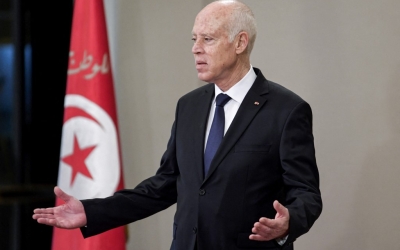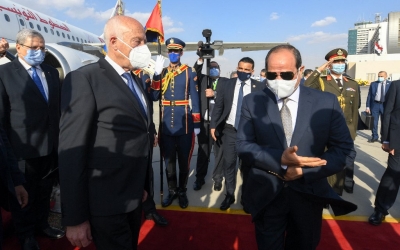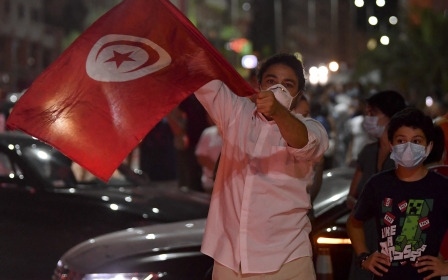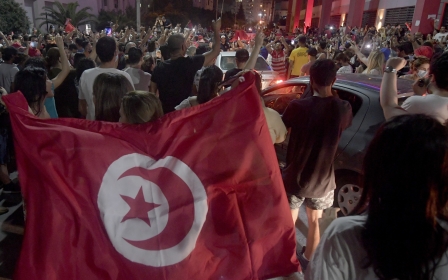Tunisia: Should the constitution be revised?

By activating article 80 of the constitution, a controversial decision that grants him exceptional powers, Tunisia's President Kais Saied has gone much further than simply suspending the regular institutional order.
His decision marked the failure of the institutions created by the 2014 constitution to address the grave problems that threaten the state’s stability. The multidimensional health, financial, social and political crises, for which those institutions may be partly responsible, have killed the hopes invested by Tunisians in their Arab Spring revolution and in democracy.
The gap between the legitimacy of a diminished and discredited parliamentarian majority and that of Saied led to a conflict at the highest levels
Gone are the emotions of January 2014, when the assembly adopted Tunisia’s first democratic constitution. Seven years later, that constitution feels like a dead object - a lifeless Aladdin's lamp unable to fulfil any wishes.
The formation of a constitutional court, which should have been in place in 2015, never happened because of a lack of political agreement. The number of constitutional articles that were never implemented or proved ineffective would be too long to list exhaustively: non-discrimination clauses, the abolition of military courts for civilians, the right to water, laws against tax evasion and corruption, provisions dealing with economic favouritism, judicial independence, and so on.
The economy is generating as much social injustice as before. But the greatest failure of the constitution has been in its democratic institutions, which have proven powerless to transform the country’s realities.
The Tunisian population is losing hope. When the country does still attract the world’s attention, it is due to the collapse of its medical system or failure to pay back its foreign debt.
Several power centres
The main complaint against the constitution is precisely its central focus: wherever a concentration of power was found, that power was split between several poles. The new regime was supposed to prevent two dangers: the possibility of a new autocratic presidency, thanks to the government’s dependence on parliamentary majorities; and the possibility of a majoritarian legislative party that could consolidate its status within the state by concentrating all powers. To prevent that, presidents would be elected by popular vote and thus enjoy direct electoral legitimacy.
A complex apparatus of independent authorities, including a constitutional court and supreme judicial council, was supposed to be independent of political institutions. Their independence was to be guaranteed by their financial autonomy and nomination mode.
In this constitutional framework, which respects the “good practices” of liberal democracies, it would be impossible for a single political actor to seize all powers. The obligation to “compromise” was constitutionalised at almost all levels of institutional life.
But there are two types of “consensus”: a “noble” one, where the choices transcend the mere interests of political parties; and a “mercantile” one, where the goal of political transactions is to maximise one’s personal benefits. The former can produce qualitative political transformations, while the latter tends to maintain the status quo.
The “consensual” nature of a democratic transition founded on transactions and deals between new and old elites (namely, between the Bourguibists and the Islamists) has privileged the second form of consensus. From 2015 to 2019, that consensus proved incapable of delivering ambitious reforms, because it was undermined by the distrust between its main two forces, Ennahda and Nidaa Tounes, and by the latter’s deterioration. The 2019 elections punished that failure. Nabil Karoui’s party, Qalb Tounes, which claimed the heritage of Nidaa Tounes after the 2019 elections, was not strong enough to keep together a political deal supported by a weakened majority.
The gap between the legitimacy of a diminished and discredited parliamentarian majority and that of Saied led to a conflict at the highest levels, which paralysed a government whose days were clearly numbered. As Tunisians, disillusioned by the “consensus”, sent to Carthage a president who was opposed to the transactional character of a democratic transition that allowed the “corrupt” elite to consolidate power, the centrepiece of the new constitution was paralysed.
Solutions and dead ends
How could the constitution’s structural flaw be addressed? Ennahda is the party most attached to the parliamentarian nature of the regime, which is also the condition of its political existence as the main party in Tunisia’s political landscape. To improve the efficacy of the parliamentarian system, it advocates changing the ballot mode to give more weight to the main political formations and allow for more stable majorities.
This seems a logical solution from a quantitative perspective, but it neglects questions of qualitative representation - the necessary condition of political stability. In that respect, the party system Tunisia inherited was born out of dictatorship and clandestine circumstances. It is not the organic result of struggles and conflicts within society, but of rivalries and power games among elite castes competing for control of the state.
The parties are therefore not focused on the interests or sensitivities of the people. They are merely apparatuses whose goal is to distribute jobs and favours - lobbies working for hidden and secret clients.
The young Tunisian democracy is thus struggling to generate genuinely representative parties. Consolidating the influence of parties disconnected from their society, and making it even harder for new forces to cross the parliamentary threshold, could only widen the gap, discredit the political class further and give power to an even narrower political base.
The other option that is more often invoked to increase the effectiveness of institutions is to re-presidentialise the regime. The notion of a presidential regime usually refers to the archetypal model of the US, where the president selects administration officials within a strict framework of separation of powers. Congress enjoys substantial prerogatives and generous means, allowing it to exert strict control over the executive.
But many understand this as a return to a unique power centre as the sole or main source of political projects and transactions, often linked to a dominant political party; in other words, a personal form of power rather than a genuine presidential system, which in order to avoid autocracy must include genuine checks and balances, such as an independent judiciary and non-partisan media.
Saied's project
Saied’s presidential project consists of “inverting the pyramid of powers”. A multiparty system and free elections are not enough to guarantee genuine popular sovereignty or to address the root causes of the revolution, including social fractures and the unequal treatment of citizens. Saied may submit this project to a referendum during his period of exceptional powers. His idea is to substitute territories for parties in the selection of candidates through a grassroots electoral system.
Some have seen in Saied the influence of 19th-century French libertarian socialist Pierre-Joseph Proudhon. But given the importance the Tunisian president gives to the state - for him a quasi-mystical entity - it is difficult to describe him as a libertarian or an anarchist. Others have seen a Libyan influence, but there is no trace of tribal institutions in his project.
That system could also generate an anarchic, uncontrollable proliferation of local powers of all sorts that would compete for the allocation of resources
At most, one could find a similarity with the communal councils instituted by former President Hugo Chavez in 2006 in Venezuela, a system that decentralises politics by granting people the power to decide how to use income locally. But the articulation between territorial prerogatives and local institutions on the one hand, and the state on the other, is not clear.
This option can nonetheless be described as a populist one in the historical sense of the term, not in the negative one typically used to discredit any criticism of representative democracy. It is populist because the goal is to increase democracy, to give it more substance by turning people into genuine political agents. But that path, too, is risky; “populism from the top down”, where a regularly elected leader has a monopoly on popular representation, would inevitably lead to dictatorship, no matter how well-intentioned that leader may be.
Grassroots populism from the bottom up, with a genuine popular base, can also drift away from democracy. It can strengthen or legitimise the concentrations of power that already exist locally, or create new ones by allowing well-positioned players to serve their own interests.
That system could also generate an anarchic, uncontrollable proliferation of local powers of all sorts that would compete for the allocation of resources, forcing the state to increasingly control them, and thus defeating the initial purpose. In a nutshell, any option has its pros and cons.
Established powers
So how is it possible to break the gridlock? By looking elsewhere and finding other models.
The main error of 2014 was in following the constitutionalist tradition and believing that it is through law that one can transform a whole society. The clean slate/white page model refused to be influenced by experts offering readymade texts.
But instead of a white page, the constitution is a palimpsest - a hypertext that incorporates other texts and even subtexts, implicit norms and de facto established powers that perpetuate themselves and derive their effectiveness from the fact that they are, precisely, not written and spelled out. As such, no text, such as a new constitution, can undo them.
We are talking here about the conception that the top civil servants have of their role and of themselves; the channels of influence and revolving doors between business and political circles; the myriad local powers that can inflect, change, divert or ignore administrative or political decisions; the collusion and corruption of media by money; the way in which police and the justice system engage in favouritism with full impunity; the excessive weight of police forces because of the primacy of security concerns; Tunisia’s financial dependence on foreign countries; the privatisation of expertise by international firms who all think the same way for the definition of public policies … and the list goes on.
Rooted in political parties whose main motivation was to protect their own interests, and blind to those de facto real powers, the 2014 constitution failed to keep the promises made to the 2011 revolutionaries.
We now see the result of such failures. The fracture between society and institutions that cannot meet the people’s needs has never been so deep. And it is in that gap that Saied has inserted himself.
The views expressed in this article belong to the author and do not necessarily reflect the editorial policy of Middle East Eye.
This article has been translated and condensed from the MEE French edition.
Middle East Eye propose une couverture et une analyse indépendantes et incomparables du Moyen-Orient, de l’Afrique du Nord et d’autres régions du monde. Pour en savoir plus sur la reprise de ce contenu et les frais qui s’appliquent, veuillez remplir ce formulaire [en anglais]. Pour en savoir plus sur MEE, cliquez ici [en anglais].








